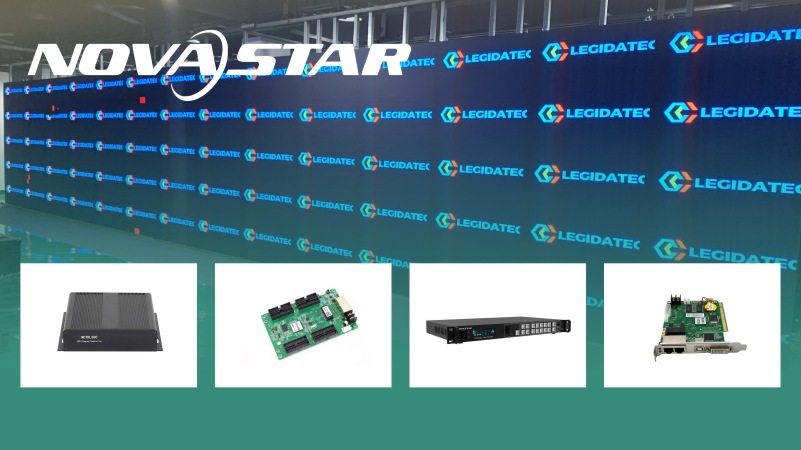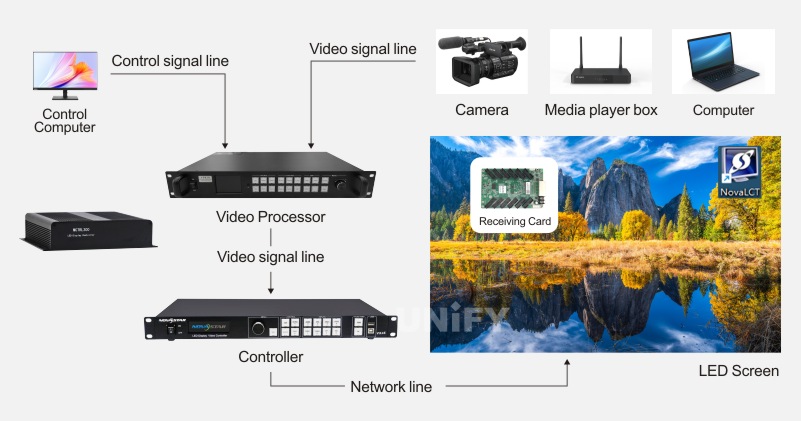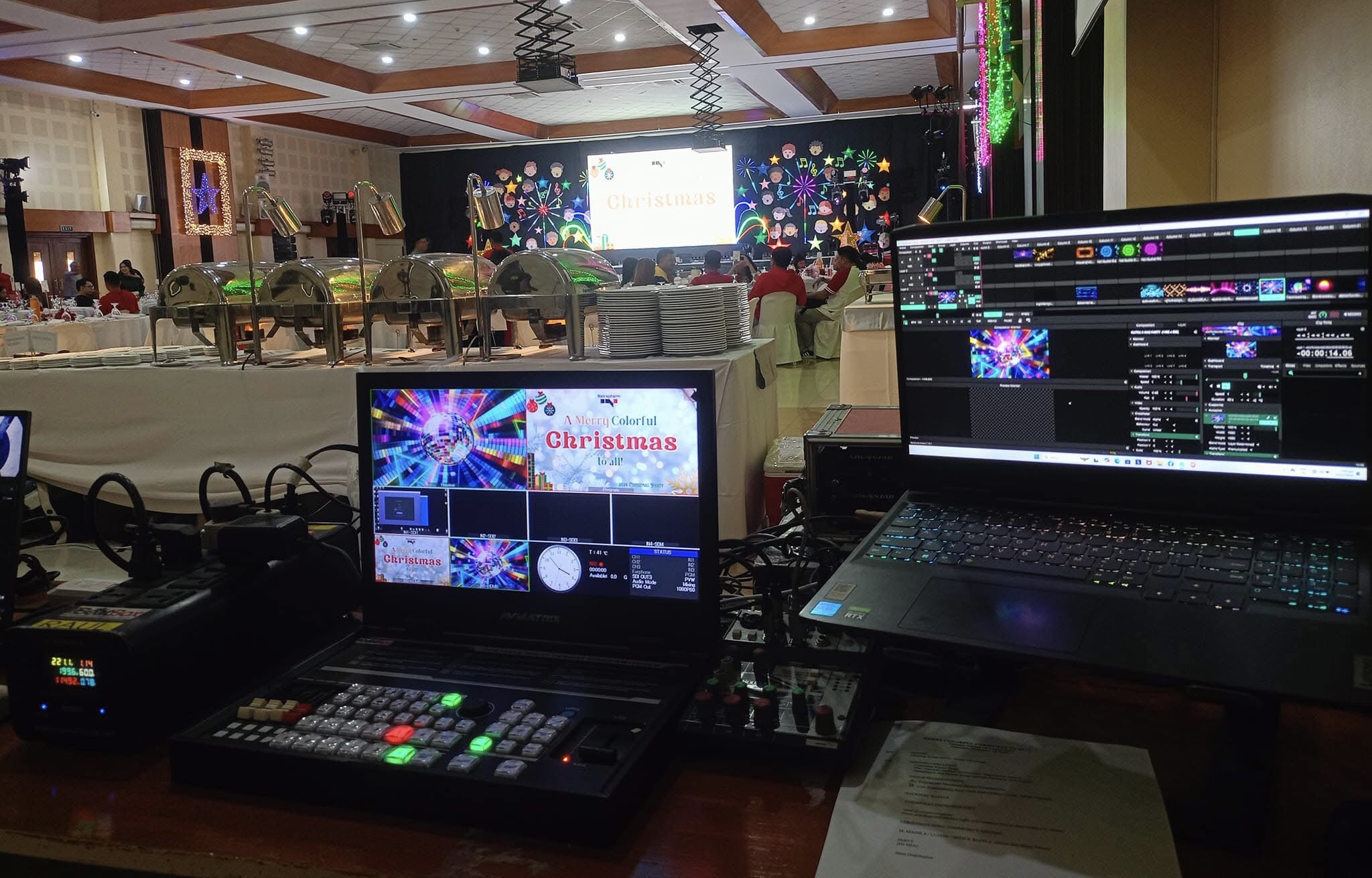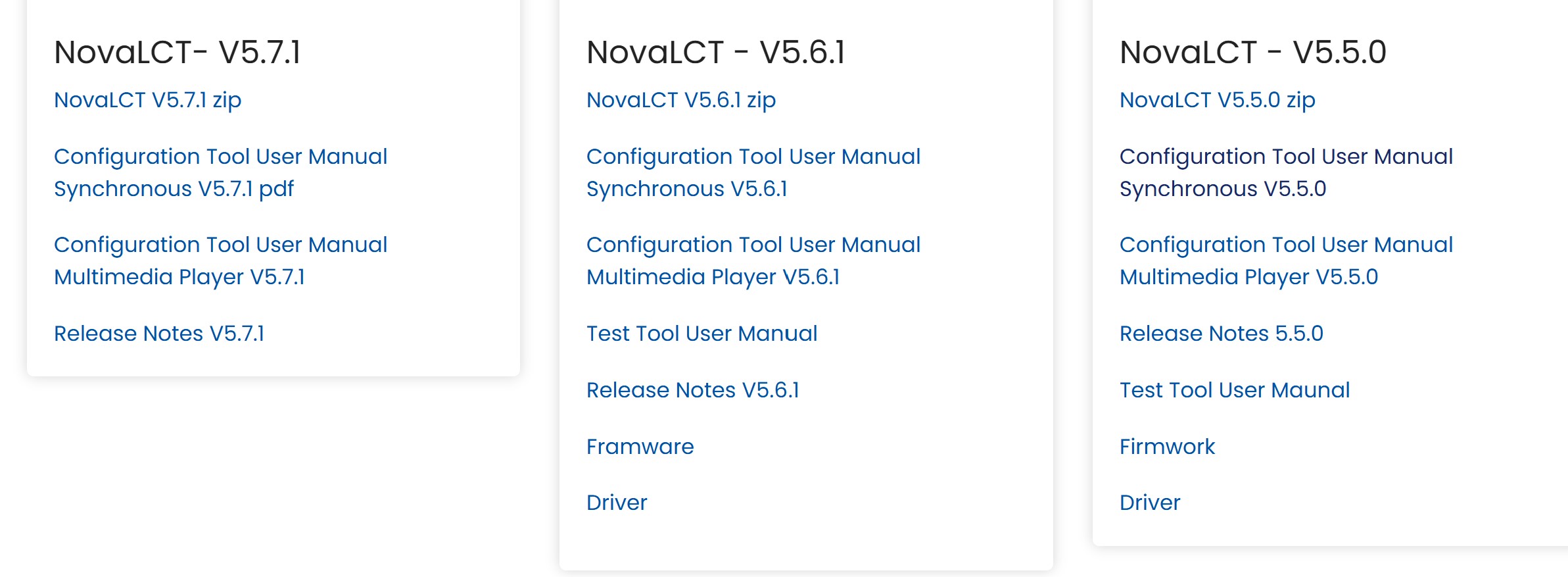Download - Novastar System
LEGIDATECH specializes in mid-to-high-end LED display solutions and maintains close partnerships with internationally renowned control system manufacturers such as Novastar and Huidu, ensuring stable support for our customers’ projects.
Here, you can conveniently browse and download official documentation and materials for selected control systems, including user manuals, software drivers, and configuration guides, helping you quickly get started and resolve installation and commissioning issues in a one-stop manner.
Novastar LED Controler-1
Novastar LED Controler-2
Novastar LED Control System-1
Novastar LED Control System-1
Novastar LED Control System-3
Novastar Armor Series Receiving Cards
Novastar MRV Series Receiving Cards
NovaStar Control System Detailed Explanation: Products, Applications, Selection, and Download Guide
1. Introduction
LEGIDATECH has established a long-term, close partnership with NovaStar. When providing comprehensive LED display solutions to our customers, we always consider NovaStar’s control system a key component.

This partnership ensures that every LED display achieves optimal display quality and the most stable operation.
To help customers better understand and use these control systems, we have organized NovaStar’s relevant software, product specifications, and firmware versions in our download section, providing a one-stop resource for all necessary resources.
What is the NovaStar control system?
The NovaStar control system is a dedicated hardware and software solution for the management and operation of LED displays.
It acts as the “brain” of the LED screen, processing images and data from computers, video sources, or other signal sources, and then accurately transmitting them to the LED modules, enabling stable and clear display.

A complete NovaStar control system typically consists of the following components:
Transmitter/controller (such as the MCTRL and VX series): Responsible for receiving external signals, processing, and distributing them.
Receiver card (such as the MRV and Armor series): Installed within the LED module, it converts the controller’s signals into pixel-by-pixel display for the LEDs.
Control software (such as NovaLCT): Used for screen parameter configuration, color correction, grayscale adjustment, and operational monitoring.
NovaStar systems are widely used in stage performances, advertising media, stadiums, transportation hubs, conference centers, and other applications.
Its advantages lie in its high stability, strong compatibility, and versatile functionality, meeting diverse needs, from small indoor screens to ultra-large 8K/4K outdoor screens.
Simply put, if an LED display is a human body, with the screen body serving as the “muscles and bones,” the NovaStar control system is the “nerves and brain,” ensuring optimal image quality and operational performance.
3. NovaStar Product Range and Technical Features
| Product / Series | Main Application / Suitable Scenarios | Key Technical Features / Advantages |
|---|---|---|
| NovaLCT Software | LED screen configuration, color calibration, grayscale adjustment, synchronous & asynchronous settings | Supports multiple versions (e.g., V5.7.1); strong compatibility; includes both synchronous configuration and multimedia playback setup tools; release notes, drivers, and firmware available for the latest updates. |
| MCTRL Series Controllers | Medium to large LED displays, stage screens, outdoor billboards requiring high-performance processing | Models such as MCTRL4K support ultra-high resolution input; MCTRL660 PRO ensures fast refresh and stable output; frequent firmware updates enhance stability and add new functions. |
| VX Series Controllers / Video Splicing Processors | Multi-signal input and large-scale video wall splicing needs, such as conference centers, control rooms, and stage backdrops | Supports multi-channel input, splicing matrix; Pro versions feature stronger processing power and more versatile interface options. |
| Receiving Cards (Armor Series, MRV Series, etc.) | Core hardware for driving LED modules; improper matching with controllers or screens can affect performance and stability | Armor Series emphasizes new features and high refresh rates; MRV Series offers various models optimized for different pixel pitches, bandwidth, heat dissipation, and power requirements. |
4. Typical Application Scenarios and Recommended NovaStar Control Systems
4.1. Stage Rental/Performance Event LED Walls
Features: Stage and event rental screen scenarios require rapid setup and dismantling, with screens frequently moving around. These scenarios place extremely high demands on the system’s high refresh rate, low latency, and real-time signal processing capabilities.

Recommended NovaStar Solutions:
MCTRL660 PRO / MCTRL4K — Mainstream stage controllers supporting high-resolution, HDR displays, and low latency.
VX600 / VX1000 Video Controllers — Integrated splicing and scaling functions, allowing direct access to multiple signal inputs, eliminating the need for external video processors.
A8s / A10s Pro Receiver Cards — High refresh rates (3840Hz+) ensure ripple-free camera footage, making them ideal for stage broadcasts and concerts.
4.2. Commercial Exterior Walls/Outdoor LED Advertising Screens
Features: These screens are exposed to outdoor conditions for extended periods and require waterproof, dustproof, and weather-resistant properties. Furthermore, they must support remote updates and scheduled playback, and maintain high brightness even in direct sunlight.

Recommended NovaStar Solutions:
TB Series Multimedia Players (TB50/TB60/TB8) – Features a built-in asynchronous control system, enabling remote updates of advertising content via mobile phone, computer, or cloud.
MCTRL660/MCTRL4K – Designed for synchronous control of ultra-large screens, supporting high-brightness outdoor displays.
A5s/A10s Plus Receiver Cards – Offer excellent stability, suitable for long-term operation of large-area advertising screens.
NovaLCT Software + V-Can – Supports remote management, scheduled power on/off, and program publishing.
4.3. Conference Center / Command Center / CCTV Display Wall
Features: Large conference and security surveillance scenarios typically require multiple signal inputs, flexible splicing, and 24/7 operation, demanding extremely high stability and color reproduction.

Recommended NovaStar Solution:
VX1000 / VX16s Video Controller – Features built-in splicing and switching functions, supporting real-time display of multiple input sources.
H Series All-in-One Splicing and Controller (such as the H2 / H5) – Supports multi-screen splitting, window roaming, and image zooming, making it ideal for monitoring and command and dispatch centers.
A10s Pro Receiver Card – Ensures high grayscale and high contrast, suitable for long-term display of detailed images.
SmartLCT Software – Provides a more intuitive layout, suitable for managing complex splicing solutions in command centers.
4.4 Transportation Hub / Information Dissemination LED Screen
Features: Frequent information updates require high stability and ease of maintenance. Furthermore, automatic playback is required to ensure uninterrupted information transmission even when the network is unstable.
Recommended NovaStar Solution:
TB Series Players (TB30/TB50/TB60) – Built-in storage allows for continuous playback even when the network is disconnected.
MCTRL300/MCTRL600 Controllers – Suitable for small and medium-sized transportation hub information screens, simple and easy to use.
A5s/MRV328 Receiver Cards – Affordable, stable, and suitable for information-driven screens.
V-Can Publishing System – Enables unified management of multiple locations, facilitating information dispatch at stations and airports.
5. How to Choose NovaStar control system
When selecting a NovaStar control system, performance and functionality requirements vary significantly from project to project. To help customers quickly find the right product, consider the following dimensions:
1. Display Size and Pixel Pitch
ل fine-pitch screens (such as P1.2, P1.5, and P1.8): These screens require high data transmission bandwidth and refresh rates. We recommend using controllers like the MCTRL4K or VX1000, which support ultra-high resolution and 4K input, paired with high-specification MRV series receiver cards to ensure image quality and synchronization.
For medium-pitch screens (such as P2.5 and P3.91): These are commonly used for stage rentals and commercial displays. We recommend the MCTRL660 PRO + VX6S, which provide stable output and multiple input interfaces for flexible applications.
For large-pitch screens (such as P6 and P10 outdoor advertising screens): These screens require relatively low resolution but require stronger asynchronous playback and remote control capabilities. We recommend the MCTRL300 paired with the NovaLCT + asynchronous playback system.
2. Content Type: Still/Video/Live Broadcast/Multi-Input
Static Ads/Image Playback: Low controller performance requirements are recommended; the entry-level MCTRL300 or VX4S are sufficient.
HD Video Playback: High refresh rate and grayscale are required to avoid ghosting and lag. The VX6S or VX1000 is recommended.
Live Broadcast/Concerts: Low latency and stability are required. The best solution is the MCTRL660 PRO paired with the high-refresh receiver card MRV336.
Multi-Input Splicing/Conference: Processing multiple signal sources and splicing them into a large screen is required. A splicing processor like the VX1000 with multi-channel input and window splitting capabilities is recommended.
3. Synchronous vs. Asynchronous Playback
Synchronous Systems: Suitable for scenarios requiring real-time playback, such as stage performances, conferences, etc. The controller directly receives and outputs video signals. NovaStar’s MCTRL and VX series are both synchronous controllers.
Asynchronous System: Suitable for advertising screens and large commercial screens, supporting offline playback, scheduled updates, and remote management. NovaStar provides ViPlex software, which can be used with asynchronous playback boxes (TB series) to meet advertisers’ needs.
Hybrid Synchronous + Asynchronous: Some scenarios require both remote publishing and on-site access. NovaStar’s all-in-one processor, the VX6S, can handle both.
4. Refresh Rate/Grayscale/Brightness Requirements
High Refresh Rate (≥3840Hz): Suitable for stage performances, live broadcasts, and TV broadcasts, to avoid streaking during recording. The VX1000 and MRV receiver cards are recommended.
High Grayscale (16-bit or higher): Suitable for exhibition halls, museums, and film and television broadcasts, requiring high image quality.
High Brightness (≥6000 nits): Suitable for outdoor advertising screens, ensuring clarity even under strong sunlight. The MCTRL4K and the Armor series waterproof receiver card are recommended.
5. Environmental Conditions and Stability
Outdoor Applications: For applications exposed to wind, sun, high temperature and humidity fluctuations, select receiving cards with high protection levels and excellent heat dissipation, such as the Armor series.
Command Centers/Transportation Hubs: For 24/7 operation, a redundant backup system (dual power supplies, dual network cables) is recommended, along with a controller with stable firmware, such as the MCTRL660 PRO.
Touring Rentals: Frequent installation and removal require high interface and connection stability. The impact-resistant MRV336 or A8s receiving cards are recommended.
6. Maintenance and Upgrade Ease
NovaStar’s NovaLCT software supports fast debugging and color calibration. Users can obtain the latest version through the official website or partners (such as the UnifyLED download area).
Firmware Upgrades: All controllers and receiving cards offer firmware upgrades to resolve bugs and enhance new features.
Remote Maintenance: The asynchronous system supports remote publishing and monitoring, making it particularly suitable for advertising agencies and cross-regional operations.
6. How to Use NovaStar Resources from LEGIDATECH Download
Below are some step-by-step recommendations for your customers to utilize these resources to improve efficiency and success:
Confirm Model/Version
Before purchasing or installing, confirm the controller model you will use (e.g., MCTRL700/VX1000/Armor series receiving card, etc.) and whether it requires the latest firmware or software support. Find the corresponding datasheet and firmware version on your download page.
Download the Corresponding NovaLCT Version
If your control system requires NovaLCT (configuration tool, etc.), download the appropriate software version for your device, along with the corresponding user manual/test tool/driver. UnifyLED offers multiple versions to ensure compatibility with different products.

Read the Specifications and Quick Start Guide
The datasheet will include information such as power consumption, supported input types, refresh rate, connection method, and network requirements. This information is crucial for installation and commissioning. The Quick Start Guide can help with quick on-site setup and testing.
Firmware Updates and Release Notes
New firmware versions often fix bugs, add new features, or improve compatibility. Check the release notes to determine whether the updates are helpful or risky for your project.
Testing and Debugging
Use NovaLCT’s testing tools (such as grayscale and synchronization tests) to verify that the display output is compatible with the control system, receiving card, and LED module.
Saving Versions and Backing Up Data
Once a system is running stably, it is recommended to record the software/firmware version at that time to prevent compatibility issues caused by future upgrades.
7. Installation and Maintenance Recommendations
When using the NovaStar control system, proper installation and scientific maintenance are crucial to ensuring the long-term stable operation of the LED display. The following are some common operating points and practical suggestions:
1. Hardware Wiring and Power-On Precautions
Wiring Specifications: Signal and power cables should be routed separately to avoid interference. It is recommended to use high-quality Category 5e or Category 6 shielded network cables to ensure stable signal transmission.
Wiring Sequence: First connect the receiving card and controller, then the power supply, and finally ensure that the grounding is good.
Power-On Sequence: Generally, connect the signal first, then the power supply. When shutting down, the reverse sequence should be followed to avoid shock to the receiving card and controller.
Connector Securing: For rental or outdoor projects, use aviation or industrial plugs with locking latches to reduce looseness and accidental disconnection.
2. Software Debugging and Parameter Calibration (NovaLCT Operation)
Basic Configuration: Use the NovaLCT software to load screen parameters, set the module scanning mode, and adjust the brightness/grayscale curves.

Color Consistency Correction: Correct module color differences point by point or in batches to improve uniformity across the entire screen.
Test Mode: During factory delivery or installation and debugging, you can enable red/green/blue/white test patterns to quickly determine if the module and receiving card are functioning properly.
Save and Backup: After completing parameter configuration, export and save the configuration file for easy restoration.
3. Firmware Upgrade Process
Upgrade Channel: Obtain the latest version from NovaStar’s official firmware files or from partners such as the UnifyLED Download Center.
Upgrade Method: Perform an online upgrade using NovaLCT or the controller’s built-in tool; be careful not to interrupt power or signal during the upgrade.
Version Compatibility: Before upgrading, confirm that the firmware for the controller and receiving card models match; otherwise, the system may fail to boot.
Fallback: It is recommended to back up the previous firmware version before upgrading so that you can roll back in case of an issue.
4. Redundancy and Stability
Dual Network Cable Redundancy: For critical applications (such as command centers and stage performances), it is recommended to enable dual network port redundancy to ensure automatic failover in the event of a primary port failure.
Power Supply Redundancy: Dual power inputs are configured for critical screens or control devices to improve fault tolerance.
Controller Hot Backup: Some high-end NovaStar controllers support active/backup failover to avoid single points of failure.
Monitoring and Alarms: The NovaLCT software’s status monitoring function provides real-time visibility into operating data such as receiving cards, power supplies, and temperatures.
8. Conclusion
As a leading global LED control system supplier, NovaStar’s products, with their stable and reliable performance, flexible functional design, and wide application compatibility, have become the preferred choice for stage performances, commercial advertising, command centers, and transportation hubs.
Whether it’s dynamic performances requiring ultra-high refresh rates or large-scale outdoor advertising screens requiring 24/7 operation, NovaStar provides high-quality solutions.
LEGIDATECH has always focused on providing mid- to high-end LED display solutions and has established a long-term partnership with NovaStar.
This means that by choosing LEGIDATECH, you not only receive high-quality display hardware but also industry-leading control system support, ensuring superior project performance from display quality to content management.
الأسئلة الشائعة:
1. What is a NovaStar LED control system?
NovaStar control systems are professional solutions used to manage LED displays, including controllers, receiving cards, and software like NovaLCT. They ensure smooth playback, stable performance, and high-quality image output for indoor and outdoor LED screens.
2. Which NovaStar controller is best for large LED screens?
For large or high-resolution LED displays, models like MCTRL4K أو MCTRL660 PRO are recommended. They support ultra-high resolutions, high refresh rates, and multiple input interfaces, making them ideal for concerts, stadiums, and advertising billboards.
3. What is the difference between synchronous and asynchronous NovaStar systems?
Synchronous control systems (like MCTRL + VX series) display content in real time, suitable for events, concerts, and live streaming.
Asynchronous systems (with NovaLCT software and control cards) allow pre-loaded content to run without constant PC connection, perfect for outdoor ads and information boards.
4. How do I choose the right NovaStar controller for my LED display?
Selection depends on screen size, pixel pitch, and content type. For small indoor fine-pitch displays, a controller with high refresh and high grayscale support is needed. For outdoor billboards, asynchronous controllers with remote content update are preferred.
5. What is NovaLCT software used for?
NovaLCT is the official NovaStar software for configuring LED displays. It handles brightness calibration, gray scale adjustment, synchronization, mapping, and firmware upgrades. It is essential for both installation and daily maintenance.
6. Can NovaStar controllers work with any LED screen?
Yes, NovaStar controllers are highly compatible with most LED display modules, but you must match the right receiving card (like MRV or Armor series) with your screen’s resolution and pixel pitch to ensure smooth performance.



